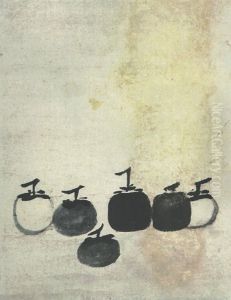Mu Qi Paintings
Mu Qi Fachang, commonly known simply as Mu Qi, was a Chinese Zen Buddhist monk and painter who lived during the Song dynasty, around the 13th century. His precise birth and death dates are not definitively known, but he is generally believed to have been active around 1210 to 1269. He was based in a monastery in the region that is today's Sichuan or possibly at the Daitoku-ji in Kyoto, Japan, according to some Japanese sources. However, the former is more widely accepted among scholars. Mu Qi is renowned for his profound influence on the development of Zen (Chan) Buddhist art in both China and Japan, where his work remains highly revered.
Mu Qi's artistic genius lay in his ability to imbue traditional Chinese subjects such as landscapes, birds, and flowers with a deep Zen sensibility. His works are characterized by a spontaneous, free-flowing brushwork that seeks to capture the essence or spirit of his subject matter rather than provide a detailed, realistic depiction. This approach was deeply aligned with Zen Buddhist principles, which value intuition and enlightenment over the formalities of rigid practice and study. Among his most famous works are the 'Six Persimmons' and a set of paintings depicting a crane and a gibbons, masterpieces that exemplify his minimalist style and profound understanding of Zen philosophy.
The 'Six Persimmons', in particular, is celebrated for its apparent simplicity yet profound depth. The painting features six persimmons on a plain background, rendered in varying shades of ink. The composition, balance, and brushwork of the painting reveal a sophisticated understanding of the principles of harmony and balance, as well as an exquisite command of the brush. This piece, like much of Mu Qi’s work, is often interpreted as a meditation on the nature of existence, embodying the Zen teaching of seeing the extraordinary in the ordinary.
Mu Qi's influence extends far beyond the borders of China. His work had a significant impact on the development of Japanese Zen painting, where his pieces were highly regarded and emulated by Japanese monks and artists for centuries. In Japan, his paintings were considered treasures in Zen temples, and his style deeply influenced the Japanese suiboku-ga (ink wash painting) tradition. Despite the lack of concrete records about his life, Mu Qi’s legacy as a master painter and a pivotal figure in the Zen artistic tradition is undisputed, making him one of the most important figures in the history of East Asian art.
